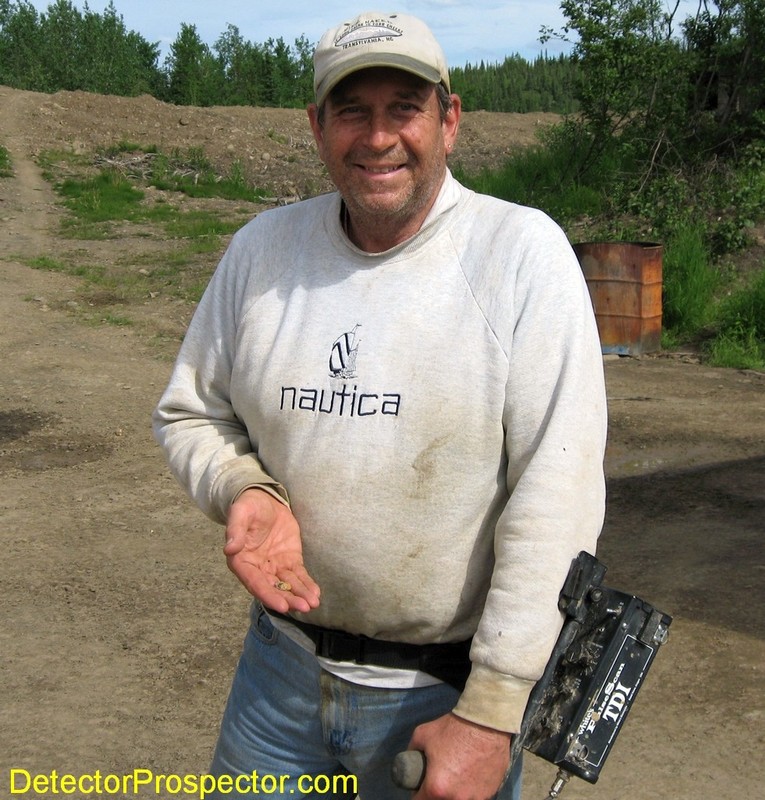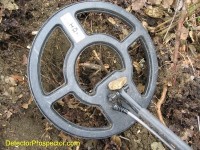
In 2007 I was sent a prototype of the White's PulseScan TDI to test, and I was so impressed that I decided to put the new model into service at my "pay-to-mine" operation at Moore Creek, Alaska as soon as it was available. Moore Creek has mixed hot rocks that severely impede the performance of regular metal detectors. I lobbied for and got four of the very first units off the production line in the spring of 2008 and those detectors were provided to visitors at Moore Creek that had no detector of their own or who needed a backup.
These people by nature often have little or no detecting experience. I was happy to find some stock settings for the TDI that worked well at Moore Creek. I could basically set the detector for somebody and as long as they did not touch the controls it worked well. Just turn the detector on and go.
Still, experience counts for much and novices have a tough time finding gold nuggets, just due to lack of basic detecting skills. We had found in the past that regardless of the detector used we were happy if novices could just find any gold at all metal detecting during their visit. So I was very pleased that many new detectorists at Moore Creek found their very first nuggets metal detecting with the White's TDI. The unit is not only very capable but also quite easy to operate and so really the only task left to the novices was to get over a nugget.
Mike and Karl were pretty typical of many of our visitors. Never really done any metal detecting for gold and no detectors of their own. I sent them out with the TDI and they each found by far the largest gold they had ever found in their lives. The small stuff at Moore Creek is larger than many people will ever find and so I had the opportunity to create some real life experiences for a lot of people. It really is a good feeling seeing people make their first finds and knowing you made it happen.
Mike's gold specimen weighed in at 0.28 ounce and Karl got two, 0.12 and 0.25 ounce respectively.
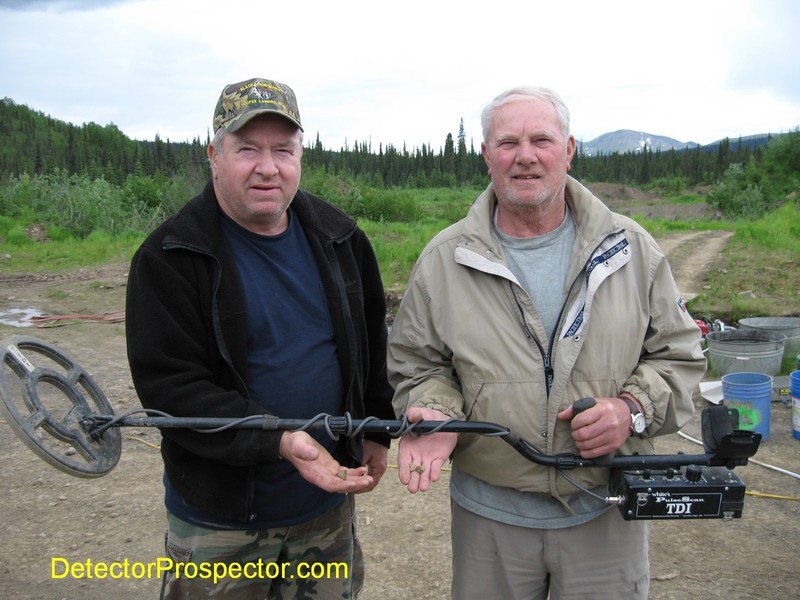
Mike B. & Karl E. of Anchorage, Alaska with Moore Creek TDI finds
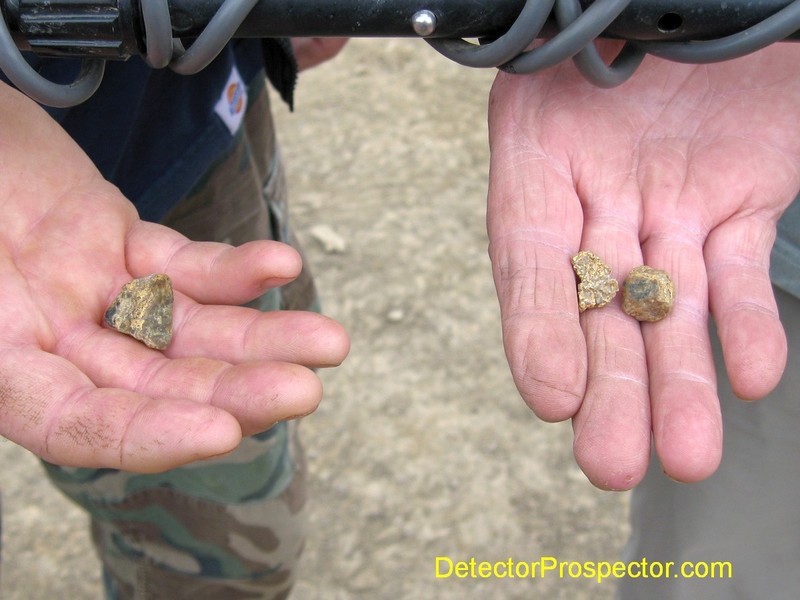
Close up of Mike and Karl's gold specimens
I was doing some bulldozing at the mine to stir up some nuggets for our visitors. I got to one little knob of gravel and after I flattened it out I thought "that looks like a good spot". I had not done any detecting in a couple weeks and figured it was about time. So when I got the dozer back to camp I got a TDI out and headed to the location. A guy had just come into camp as I was leaving and so I told him to head up the same way.
I got to the spot and started detecting. First down one row and up the other. After about ten minutes I got a nice signal, and dug up a great 0.31 ounce specimen. It is a little section of a quartz vein with a nearly solid gold core of gold running through the middle.
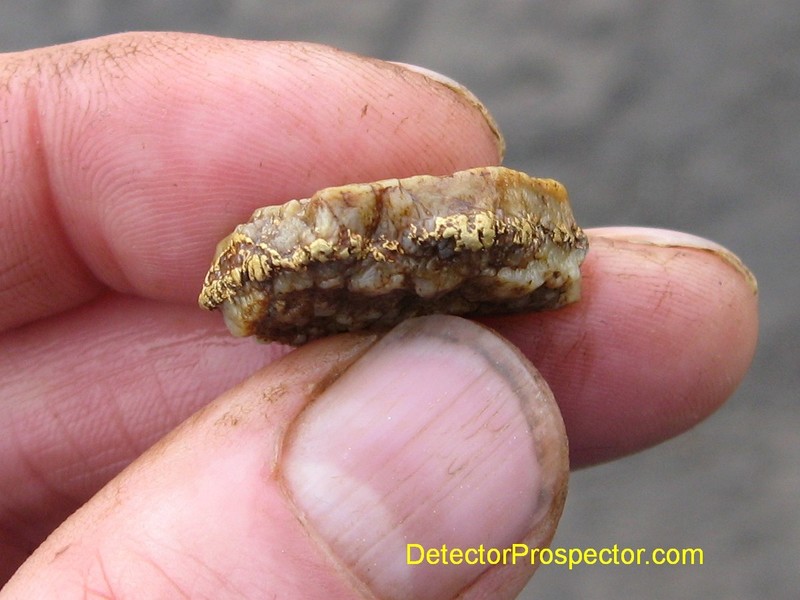
0.31 ounce Gold Specimen found with White's TDI
I turned off the detector and headed back to camp. The other guy was now just arriving and asked me what was wrong. I told him nothing was wrong, but that I'd got my nugget and so was done. You should have seen the look on his face! Poor guy had been looking for gold for days and I walk right out and find a nugget in ten minutes.
We had an 82 year old gentleman in camp that week who was not having much luck detecting so I gave the specimen to him to take home to Florida.
So what were the settings, etc. we used with the White's TDI at Moore Creek? The Pulse Delay was always at 10, the most sensitive setting for gold, and we were always able to run the maximum Gain of 12. The Ground Balance was tight as we have both a positive and negative hot rock at Moore Creek. A bit one way and the positive rocks signaled and a bit the other way and the negative rocks signaled. Negative hot rocks are by far the more prevalent. In general a setting of about 9 eliminated nearly all the hot rocks. But no matter how much I tweaked there were faint hits on some hot rocks. This is not surprising as the Minelab PI detectors also hit the hot rocks at Moore Creek. The ground is a weird mix of fairly neutral soil made up of the underlying decomposed shale bedrock with basalt and monzonite hot rocks eroded from the nearby hills.
However, I determined a couple things with the TDI that really helped with the new people. First, virtually all gold at Moore Creek gives a high tone, even multi-ounce pieces. I believe this is because of the generally high silver content combined with the specimen nature of the gold. Surprisingly, when silver is added to gold it lowers the conductivity instead of increasing it, and so low purity gold is more likely to give low conductor high tone responses on the TDI. You can figure with 99% certainty that a low tone is an iron target or hot rock at Moore Creek. I ended up with the novices ground balancing to kill the high tone hot rock responses and did not worry about low tone hot rocks. Then I set the very unique to the TDI Target Conductivity switch to eliminate low tones and only sound off on low conductivity high tone targets. This made the TDI a real no-brainer to run. Dead quiet, no false signals at all. Then get any high tone at all, and it was always a bullet or shell casing (rare at Moore Creek), some small ferrous trash that reads low conductive, or gold. The ferrous trash that reads low conductive tends to be shallow easy to dig stuff. Being set up this way almost totally eliminates the PI tendency to have a person digging deep, tiring pits only to find a big piece of steel junk.
The only problem I had was people fiddling with or accidently knocking a control out of adjustment. The setting was so perfect I actually considered just gluing the controls in place to prevent people from messing with them! Another problem happens when you loan people stuff to use - it not only gets used it gets abused. Luckily the TDI is able to take a licking and keep on ticking, just like the old ads. This TDI got strapped on the back of an ATV and then the driver forgot about it as he roared through the mud holes and brush. Having too much fun I guess! Not only did the unit get covered in mud he managed to bend the middle rod section. A little careful work with a water hose and a little bending and the detector worked just fine. I eventually ordered a new rod section to replace the bent one.
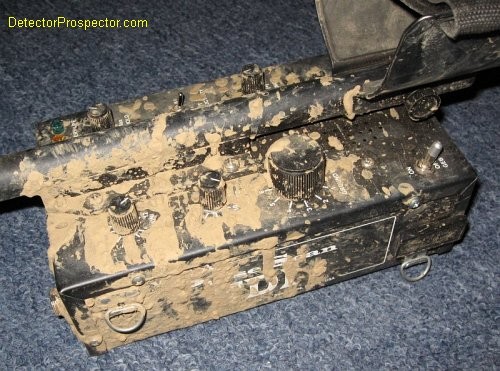
White's TDI Covered with mud!
I ran the 7.5" coil a bit and found a 1 pennyweight nugget with it. I was surprised at how stable the smaller coil was, as I expected it would be more prone to hitting hot rocks, but instead it seemed to be more immune to the hot rocks than the larger coil. At Moore Creek though the stock 12" coil is the better way to go not so much for extra depth but for ground coverage, which really is the name of the game at the mine. The person that covers the most ground digging the most targets has the best shot at finding the gold at Moore Creek. But for many nugget hunting tasks I think I would very much like using the smaller coil.
Here is Moore Creek visitor Pete W from Paducah, Kentucky. Pete hunted hard with the TDI but was having little luck. I was out with him at one point and was sitting nearby when he got a signal. He started to dig with his scoop but the target was deep, and so I came over with my pick to help. I scooped a pretty deep hole, but when he checked the target was still in the ground. The TDI got this one at respectable depth. So I dug some more and out popped a really good looking nugget! A very nice piece weighing 0.27 ounce that put a huge smile on Pete's face.
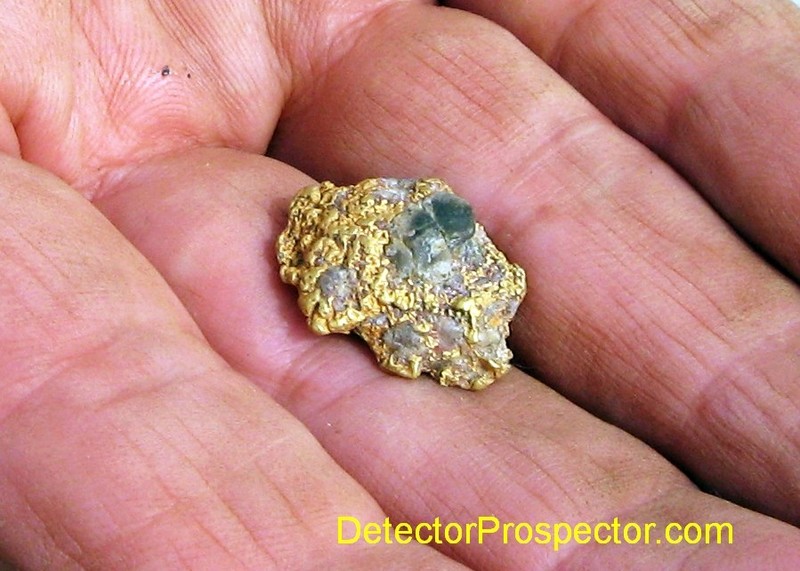
Close up of Pete's nugget found with TDI
And here is a great photo of Moore Creek visitor Jens S from Hupstedt, Germany with nuggets he found with the TDI. The larger nugget is 0.62 ounce and the smaller 0.37 ounce. Jens found the smaller nugget first within ten minutes of turning the TDI on for the first time. Jens really liked dredging and highbanking more than metal detecting and so spent most of his time at Moore Creek doing just that. From what I saw though he was a natural with a metal detector and so who knows how he would have done if he had concentrated on that more. He went home with a lot of gold anyway and a very happy visitor to our country, with an experience most will never have.
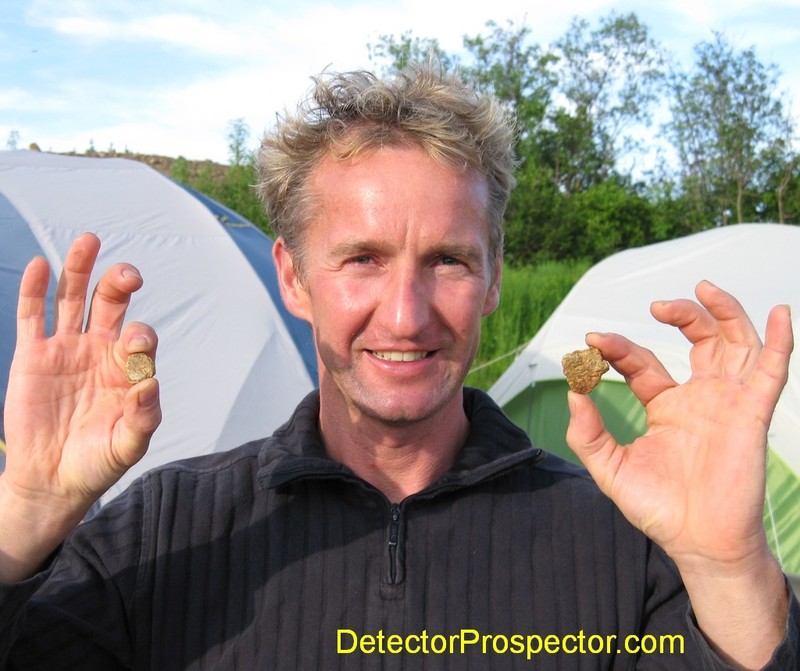
Jens with 0.37 oz and 0.62 oz gold specimens found with White's TDI
You would be surprised how little detecting I did while at Moore Creek. Running a pay-to-mine operation is a full time job and then some. Still, I did have my chances to get out now and then and having the new TDI around certainly gave me reason.
A couple of our visitors, Keith M and Bob D and I decided to hit some tailing piles downstream and across Moore Creek, making them hard to get to and so less hunted by others. We loaded our detectors and waders up on ATVs and headed down to the general location. After crossing the stream we hiked down to the lowest tailing pile which I've been eying from afar the last couple years. It has a lot of brush on it, and I figured a nugget might be lurking unfound in that brush.
The tailing piles are very steep, and so I hip mounted the White's TDI to keep the weight off my arm while side-hilling. The only issue I found in the brush was a tendency for controls to get knocked off their settings and so I was alert for changes in the detector's response. I found a good ground balance setting that minimized the response from both the positive and negative hot rocks. This ended up being about 8 on this tailing pile. I ran at the gold sensitive 10uS setting and was able to run the gain up to max. I set for a quiet, faint threshold. I do run the Target Conductivity switch on All myself as I prefer to hear the hot rocks and sort them out myself. I do not mind digging a few rocks if need be but usually they have a consistent sound I can learn. In this instance though the TDI was running real nice. There seemed to be less of the bad hot rocks on this side of the valley.
Bob, Keith, and I spaced ourselves around the tailing pile and proceeded to hunt. I started low on one end, hunted around that end, and then worked up the hill into the brush. They were both running Minelabs. Minelabs can be set to run pretty close to each other, but we discovered that the TDI does not play well with Minelab detectors. The TDI does not pick up the Minelabs at all, but the Minelabs go nuts with a TDI anywhere near, and they cannot tune the TDI out at all. So I took pains to stay as far away from both Keith and Bob as possible. I ended up in a little spruce tree thicket on one end of the pile.
Soon I got a nice, clear, high tone signal. A bit of digging revealed a nice 1.93 ounce gold quartz specimen down in the roots! It was a typical Moore Creek "oreo cookie" nugget with a solid gold core sandwiched between two thin layers of quartz. But very solid in the middle - this chunk had a very nice heft. Not only did it make my day (week? month?) but actually paid for that TDI in a single find. It certainly gave me a real warm fuzzy about the TDI being able to make a find like that with it.
We hunted most of the rest of the day and although we found many targets my nugget proved to be the only find of the day. That happens so often it does make me wonder at times. I have seen myself and others bang into a great find like that early on, and then find nothing the rest of the day so often that when it happens now I joke about it. The feeling is if you get a great one like that right off the bat you may as well quit for the day. But of course nobody ever does.
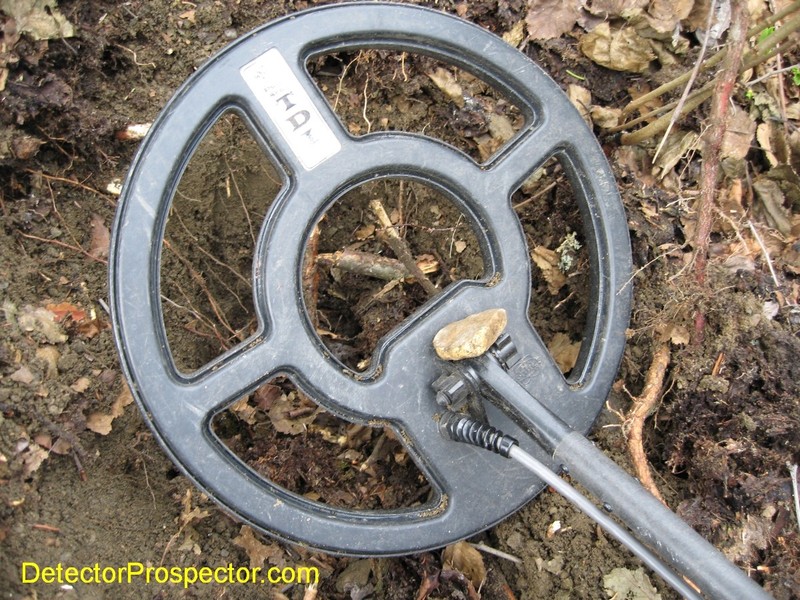
1.93 oz gold nugget found by Steve Herschbach with White's TDI
Here is the rest of the story on the nugget. I have a rule at Moore Creek that any gold our crew finds while we have paying customers in camp goes to the customers. So at the end of the week we had a drawing. Everyone got 5 tickets, and for every ounce of gold a person had found we took away one of their tickets. We wanted to handicap the hot detectorists. Although we had 15 visitors in camp, it was Bob who was with Keith and I when the nugget that got found that won it. Which was nice as he is one of our regular visitors and had not had much luck detecting. There was some pretty serious karma at work that week! Just a reminder, gold was running around $700 per ounce in 2008, so I gave away a $1400 nugget. I did this a lot at Moore Creek and in fact no visitor ever went home without gold. I always found enough hunting on the side to be able and make sure people who got skunked got a going away present. I think I found and gave away about a pound of gold, which must set some kind of record.
I was figuring there is no way anyone is going to beat my 1.93 ounce nugget for awhile. After all, not many nuggets get found over an ounce, and this one is almost two ounces. Well, I figured wrong. After all our clients left for the summer I invited a couple friends up to the mine to hang out while we shut the mine down for the winter. Husband and wife detecting team Bernie and Chris came to Moore Creek for the first time. Both are expert with VLF detectors having found pounds of gold between them with the White's MXT. Pulse induction detecting was new to them however and at Moore Creek I convinced them to set the trusty MXT aside in favor of PI detectors. Well, no worries about these two running new detectors. Bernie and Chris scored some real nice gold. In fact, Chis got the best find of the week with the TDI, and really gorgeous 2.07 ounce gold in quartz specimen. It is actually one of the more attractive pieces I saw found at Moore Creek. Instead of the usual solid layer of gold wafered between quartz this specimens has gold laced evenly and very attractively throughout the quartz. Chris not only beat me for overall weight by a bit but for sure in the specimen good looks department.
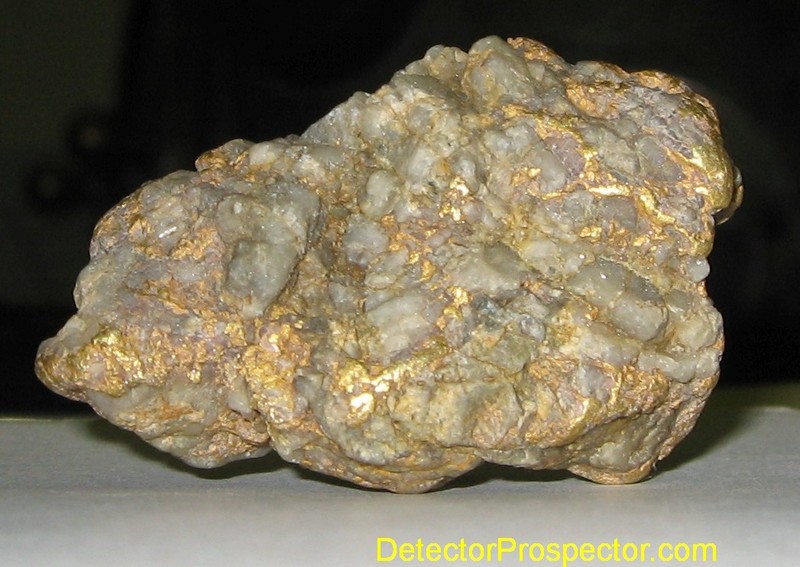
2.07 ounce gold specimen found by Chris P with White's TDI at Moore Creek, Alaska
This story is a compilation of various posts made on the internet at the time and finally added to my journal. I wanted to add a lot of missing detail, and in the process it sure brought back a lot of great memories. The Moore Creek gig will go down as the best time of my life. Not only was a lot of gold found, but many great new friends and fabulous adventures were made there. The mine now belongs to other people and the pay-to-mine operation has long since ended, but the memories will be cherished as long as I live.
The White's PulseScan TDI is a detector I still own. It has some interesting features no other detector has and in some ways is an underappreciated machine. I like the easy hip mount capability and the unique Target Conductivity switch in particular. The main problem I see is people using it in locations where a VLF is a better choice, and then complaining the TDI is no better than a VLF. Stuff like that makes me shake my head. If a location is suitable for a VLF by all means use a VLF. Pulse induction detectors like the White's TDI are for locations where the ground or the hot rocks are such that a VLF operator wants to quit in frustration. Ground Balancing PI (GBPI) detectors are meant solely to handle extreme ground or hot rock conditions, and it those conditions do not exist, then the entire reason for using the PI detector also does not exist. In low mineral ground the only real advantage GBPI detectors have is in their ability to run very large coils, and that can aid in finding deep large targets. But if no deep large targets exist to be found a VLF is often the better choice in low mineral ground, especially given the superior ability of a VLF to sort out trash targets. As always it is about using the proper tool for the job, and a location like Moore Creek is a perfect spot for a detector like the White's TDI. You can find more details on the TDI on this website at the White's PulseScan TDI page.
~ Steve Herschbach
Copyright © 2008 Herschbach Enterprises
-
 3
3
-
 1
1


